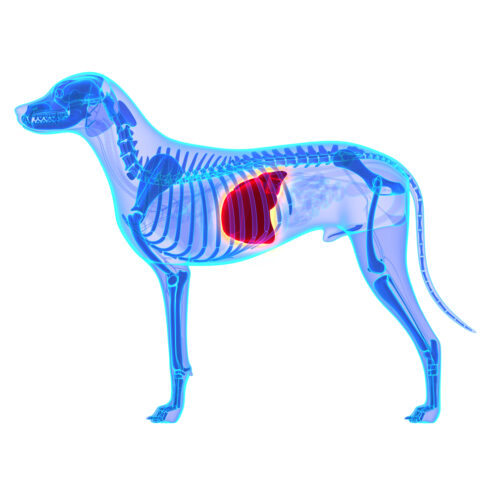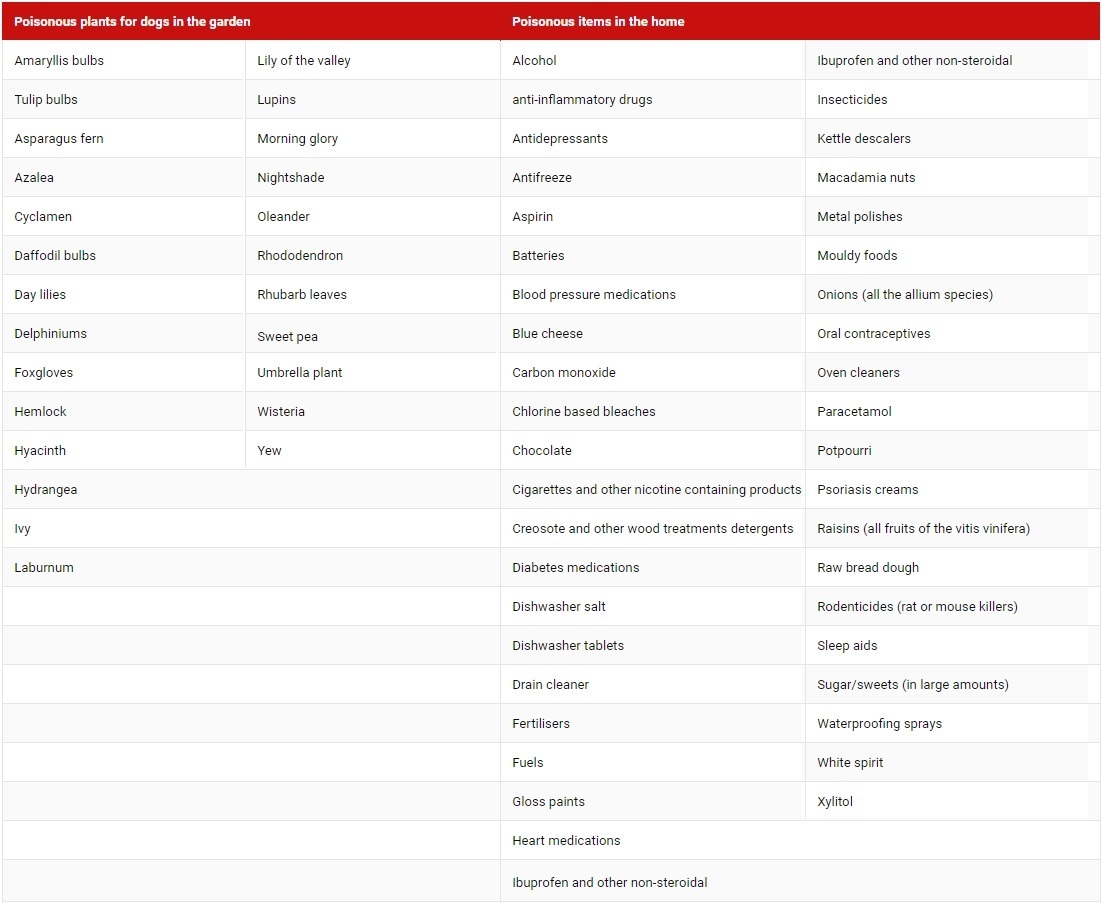How to spot dog poisoning symptoms and how to react
A comprehensive guide to dog poisoning and how you can prevent it

Symptoms that can develop when a dog has been eating chocolate
Chocolate is toxic for dogs and unfortunately one of the common dog poisons. The symptoms of chocolate poisoning can begin 6 to 12 hours after your dog as ingested it. At worst, a dog consuming chocolate can lead to death (older dogs and dogs with heart condition are at higher risk of death from eating chocolate).
The symptoms of chocolate poisoning can include:
- Restlessness
- Increased urination
- Diarrhoea
- Vomiting
- Increased heart rate
- Shaking
- Seizures
Why is chocolate poisonous for dogs?
Chocolate will stimulate your dog’s nervous system and speed up their heart rate. This is because it contains caffeine and theobromine. The concentration of caffeine and theobromine can vary depending on the type of chocolate. Cocoa powder is the most toxic, then unsweetened baking chocolate, then dark chocolate – with milk chocolate generally being the least toxic. If you know what type of chocolate your dog has eaten, this will help the vet understand the severity of the poisoning.
The symptoms can also depend on the size and weight of the dog and the amount of chocolate ingested. Even a small bar of chocolate can make a dog seriously ill, especially a small dog.
As chocolate is seen as a treat for humans, people will often think of chocolate in the same way for animals and give it to your dog as a treat. You must be particularly aware of both friends and children offering your dog a bit of chocolate out of kindness – not realising the consequences.
Excessive panting in dogs - is this a sign of poisoning?
Why do dogs pant?
Dogs pant when they are hot, happy, excited, or they have had some physical activity – this is perfectly normal. Dogs are not able to regulate their body temperature by sweating like a human can. Dogs evaporate water from the upper respiratory tract and mouth in order to circulate cool air through their bodies. Some dogs are prone to heavier breathing, such as pugs and bulldogs, due to the shape of their snouts.
Excessive panting as a result of poisoning
However, excessive panting in dogs may be a sign that something is wrong. If your dog’s panting is heavy and laboured and they are shaking, it may simply be a stress response. However, it may be an indication that your dog has overheated to a dangerous extent and has heatstroke, or that they have a serious health problem, perhaps as a result of ingesting something toxic.
Heavy panting can be the reaction to swallowing something poisonous to dogs like raisins, antifreeze, rat poison, chocolate or slug pellets.


Symptoms of rat poisoning in dogs - how can you tell if your dog ate rat poison?
Dogs are naturally curious and will explore their environment and this means they can accidentally come into contact with poisons designed to kill rodents.
If the worst happens and you think your dog has ingested some rat poison, then try to find out what type of rat poison it is as this will help the vet understand what damage it can cause. The symptoms the dog experiences are also dependent on the type of rat poisoning ingested.
Bromethalin
This type of rat poison causes your dog’s brain to swell. There is no antidote.
Symptoms include:
- Loss of balance
- Vomiting
- Shaking
- Seizures
- Lethargy
- Coma
The vet may induce vomiting with this type of poison, alongside administering medication for the symptoms.
Anticoagulant rodenticides (ACR)
ACR poisons can be fatal for dogs, but the symptoms won’t often show for 3-5 days. These rat poisons can result in internal bleeding, as they inhibit the production of Vitamin-K which is needed to clot the blood. If it is this type of rat poison, your vet will prescribe Vitamin K1 and potentially a blood transfusion and oxygen.
Symptoms include:
- Lethargy
- Difficulty breathing
- Pale gums
- Coughing
- Vomiting
- Bloody nose
- Swellings on the skin
- Bleeding gums
Cholecalciferol (Vitamin D3)
This type of rat poison increases the calcium in the body, resulting in kidney failure. There is no antidote, and your dog will need to be hospitalised.
Symptoms include:
- Weight loss
- Decreased or increased urination
- Lethargy
- Halitosis
- Decreased or increased thirst
- Kidney failure
- Shaking
If this poison has been ingested, the vet will use medication to decrease your dog’s calcium levels and IV fluids to flush the poison out.

Symptoms of antifreeze poisoning in dogs
Antifreeze is highly dangerous for dogs and should be kept well away from them. This liquid contains toxic chemicals that can bind to the calcium in their body, and form deposits in different parts of their organs.
The most common way that curious dogs come across this product, is leakages from a car or spillages on the floor. To ensure the safety of your dog, always make sure that any liquid near your car is cleaned up straight away. Even ingesting a small amount of this product can cause damage. Therefore, if you suspect that your dog has come into contact with antifreeze, be sure to seek veterinary help immediately.
Signs of antifreeze poisoning
The symptoms of antifreeze can vary between dogs. In many cases, after 12-24 hours the initial symptoms may stop, but severe internal issues will continue to occur. Typical signs of antifreeze poisoning include:
- Excessive drooling
- Vomiting
- Loss of appetite
- Extreme tiredness
- Seizures
- Excessive thirst
- Uncoordinated movement
- Diarrhoea
Can dogs recover from antifreeze poisoning?
The chance of recovery depends on the severity of the situation, and how badly internal organs such as the kidneys have been damaged. Taking your dog to the vet as soon as you suspect ingestion of antifreeze greatly increases their chance of recovery. It is essential that your vet is able to carry out a fast diagnosis, and try to protect the kidneys, by giving them the necessary medical treatments and pet medications.

Symptoms of cyanide poisoning in dogs
Cyanide is highly toxic for dogs and can be found in a variety of fruits and toxic plants, such as cherries, apples, pears, almonds, elderberries and clover. The chemical can also be found in cigarette smoke, extermination products and burning plastic.
The most common form of cyanide poisoning in dogs is from the ingestion of pits and seeds within fruit. If dogs chew or ingest broken parts of these fruit pits and seeds, the cyanide toxin can be released. Once this toxin is ingested, oxygen within the blood cannot be released as easily to the cells.
To help prevent cyanide poisoning, ensure that if feeding your dog small amounts of fresh fruit, you take care to remove all seeds, pits, leaves and stems. In addition, look out for any pitted fruit plants in the garden that your inquisitive dog could sink their teeth into.
Signs of cyanide poisoning:
Signs of cyanide poisoning usually occur within 20 minutes to a few hours after the toxin is consumed. Typical symptoms include:
- Nausea and vomiting
- Hyperventilation
- Seizures
- Tremors
- Excessive salivation
- Fast/slow heart rate
- Bright cherry-red gums
Can dogs recover from cyanide poisoning?
If your dog is able to get veterinary help quickly, then a full recovery is possible. If you’re not able to seek medical assistance quickly enough, then the chances of a full recovery decrease, due to potential damage of internal organs. There are, however, a number of effective treatment methods available. Once your dog can be brought home from the vet, they’ll need to follow a programme of mediation and rest, with you making sure that no symptoms return.
My dog is acting drunk and wobbly
If a dog looks like they are losing balance – but without spinning first – it is a reason for concern.
What causes a dog to lose their balance?
Poisoning, injury, middle ear infections, cancer or a stroke can cause your dog to become disorientated, lose balance and fall. These symptoms signal that there is a problem in the vestibular system and this is more common in older dogs.
The vestibular system maintains and stabilises the position of the head and the eyes during head movement – and therefore stabilises the rest of the body. When this system is disrupted due to ingesting a toxic substance, the dog will lose the ability to balance.


Symptoms of liver failure due to poisoning
What is acute liver failure?
Acute liver failure is a serious condition which can cause many systematic problems, including being more vulnerable to infection, digestive ulcers, fluid in the abdomen and hepatic encephalopathy.
Although there are various conditions that can lead to acute liver failure in dogs, poisoning is one of the most common causes. Poison can cause sudden and immediate liver failure.
Symptoms of liver failure
The first symptoms of liver failure are:
- Vomiting
- Weight loss
- Lack of interest in food
You must take your dog to a vet if these symptoms are apparent, as the vet will treat the dog before acute liver failure develops. Symptoms of acute liver failure are treated as an emergency, and include:
- Jaundice
- Diarrhoea with blood
- Vomiting
- Excessive thirst
- Fluid in the abdomen (and abdominal pain)
- Disorientation
- Frequent urination
- Blindness
- Excessive drooling
- Poor coordination
- Seizures
Symptoms can come on suddenly or be slow to develop. Sometimes liver failure is reversible once the problem which has caused it has been resolved, as the liver can regenerate. In other cases, cirrhosis and scarring can be left as a result. If the liver failure can’t be treated, the condition can be fatal.
Many types of poisoning can cause liver failure including:
- Antifreeze
- Medications
- Amanita mushrooms
- Some types of mould
- Herbicides
- Insecticides
- Alcohol
- Rat poison
- Fungicides
- Blue-green algae
Shaking as a symptom of dog kidney failure
Why is my dog shaking?
Dogs can often shake when they are excited or cold. However, the shaking that results from kidney failure is known as a tremor. A tremor is a spontaneous muscle contraction, often starting in the head and then moving down the body. Acute tremors can cause seizures.
Firstly, you need to ascertain the reason why your dog may be shivering and shaking. It can be caused by:
- Nervousness
- Excitement
- Damage to the nervous system
- Anxiety
- Behavioural issues
- Kidney failure
- Liver problems
- An endocrine problem (like an underactive thyroid gland or diabetes)
- Trying to regulate body temperature in a cold environment
- Cancer
Tremors can be caused by poisoning and the resulting kidney failure.
Many things which you may have in your household are toxic to dogs and can cause them to shake if they are ingested. These include:
- Raisins and grapes
- Caffeine
- Prescription amphetamines (and other prescription medications)
- Chocolate
- Bleach
- White spirit
- Insecticides
- Prescription antidepressants
- Antifreeze
- Pesticides
Many situations where a dog has been poisoned could have been prevented by making sure everyday household items which are toxic to dogs are safely stored and inaccessible to your pet.
Neurological problems in dogs
What is a neurological problem?
If your dog suffers from a neurological problem the symptoms can be very frightening. They include sudden and dramatic changes such as seizures, paralysis or violent shaking. These symptoms are caused by something going wrong in your dog’s nervous system. The network of cells that are carrying signals from the brain to the body are not functioning correctly.
Symptoms of neurological problems can include:
- Shaking
- Loss of tongue function
- Facial paralysis
- Blindness
- Paralysis of hind or front limbs
- Issues with urination
- A head tilt
- Loss of the sense of pain
- Seizures
- Inability to blink
Neurological disorders as a result of poisoning
Dogs can suffer many neurological symptoms as a result of poisoning. The dog could have ingested, or been exposed to:
- Alcohol
- Dishwasher tablets or liquid
- Drain cleaners
- Antidepressants
- Plants such as horse chestnuts
- Aspirin
- Furniture polish


Water intoxication in dogs
The main concern for most dog owners on a hot day is that their dog stays hydrated. However, when a dog ingests dangerous amounts of water in a short amount of time, the result can be water intoxication, resulting in hyponatremia.
Although the chances of this happening are rare, there are various ways in which a dog can swallow too much water and this can often happen while the dog is playing around water and swimming. It is therefore crucial that you monitor your dog’s water play and encourage them to drink slowly after physical exercise by staggering the bowls of drinking water.
What are the symptoms of water intoxication?
If you know that your dog has just had access to a large amount of water, look out for the following symptoms:
- Difficulty breathing
- Vomiting
- Excessive salivation
- Vacant eyes
- Bloating
- Loss of coordination
- Lethargy
- Seizures
- Coma
Dogs sneezing blood
What would cause my dog to sneeze blood?
If your dog starts sneezing blood, it can be a shock to see as a dog’s nose doesn’t bleed easily. It could be that your dog has something stuck up his nose like a seed or grain as dogs are always investigating new things with their noses!
More serious possibilities include cancer, tumours or poisoning. Long-nosed dogs are particularly susceptible to nose cancer which can result in bleeding from the nostrils.
The following problems can all cause your dog to sneeze blood:
- Bacterial Infections and allergies – sneezing can often cause nose bleeds
- Ingesting rat poison or other pesticides
- Nasal mite infestation
- Tooth and gum problems
- Cancer and tumours in the nose


Get in touch with the experts
If you want to find out more about our canine health and nutrition course, contact one of the GroomArts team members today and they will be happy to help you and arrange a visit.

